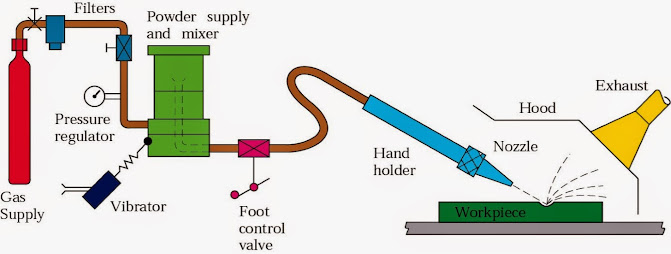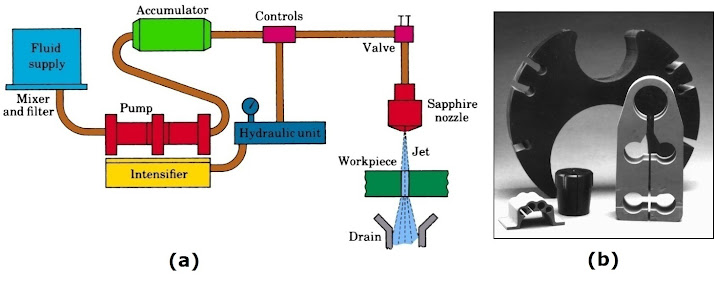EDM is a non-conventional machining technique uniquely used for cutting metals which are not possible to cut with traditional methods. EDM only works with materials which are electrically conductive. Delicate cavities and intricate contours which are difficult to produce with a grinder or other machines can be done with Electrical Discharge Machining or EDM. The cutting tool for EDM may be made of hardened too steel, titanium carbide or inconel or kovar.
EDM is also known as "Spark Machining" . Such name has been given for the fact that it removes the metal by applying a rapid series of repetitive electrical discharges. An electrode and the work piece is used for the conducting path of these electrical discharges. A continuously flowing fluid is always flowing to flush away the little amount of material that are removed. Repetitive discharge gives the workpiece a desired shape.
Two primary EDM methods are
Ram EDM and
Wire EDM.
Between this two methods the main difference is found in the electrodes. In ram EDM graphite electrodes are used. These electrodes are machined in traditional tools and a special shape is given which is connected to the power source. The electrodes are also connected to a ram. When all the arrangements are ready the electrodes are fed into the workpiece. The entire process is performed under a submerged fluid bath. In Wire EDM the electrode it self is a thin wire. Specially processed brass wires are used for feeding into the material. Electrical discharges cut the w/p according to desired shape. Wire EDM is generally done while submerged in a bath of water.
Ram Electro-Discharge Machining (EDM) Process:
Rapid recurrence of spark produced between the two electrodes (tool & w/p) controls the metal erosion. It is to be noted that the workpiece must be an electrically conducting metal. An appropriate gap is necessary which is usually approximately 0.025 to 0.075 mm known as spark gap. The gap must be maintained between the w/p and the tool by a servo motor which runs by the difference between a reference and gap breakdown voltage. The tool moves upwards and downwards by this operating motor.
The rate of metal removal depends on the spark gap. If both the electrodes are made of same materials then the highest erosion is found on the positive electrode or the anode. So logically to get a high metal removal rate and a greater tool life the tool is made as cathode and workpiece works as anode, The two electrodes are kept apart and are separated by a dielectric fluid. A transient electric discharge is found across the gap between the two electrodes in the form of spark. When the potential difference between the electrodes is sufficient, the dielectric fluid is ionized and break down which in terms produces an conductive spark channel. The current is discharged across the channel by the condensers as spark. If the potential difference is less than or equal to 12 volts the dielectric fluid is deionized. The process is repeat itself as the condensers start to recharge. The spark interval is generally 10 to 30 microseconds and the current density ranges from 15-500 am/mm2. The energy is released from the sparks in the form of local heat and eventually local temperature found is in the order of 12000°C. Such high temperature and pressure melts and erodes some metals some of which is vaporized and other fine material particles are carried by the fluid circulating around the electrodes which creates a crater on the w/p. As the time interval of the sparks is very low the heat doesn't get time to conducted between the tool & workpiece. Fig below shows a schematic diagram of the whole process.

How to choose the Tool Material
Many factors are needed to be taken into consideration while selecting the tool material.
- Low erosion rate and decent work to tool wear ratio
- good electrical conductivity
- good machinability
- low electrical resistance
- high melting point .
- high rate of electron emission
EDM has one major drawback and it is the wear ratio of the tool. Different material has different wear ratio. For Brass it is 1:1 . For metallic electrodes it is found 3:1 or 4:1 . For high melting point electrode graphite it ranges from 5:1 to 50 :1 .
Tool Wear
While applying EDM the tool or cathode also erodes which is not desirable. It is unavoidable but remains in tolerable limit as the wear of the cathode is much less than the anode. This occurs because -
- Positive ions from the dielectric fluid hit the cathode but electrons strikes the anode. Though electrons are much lighter than the positive ions it possesses more energy as it moves it greater velocity. So anode gets more eroded.
- At the time of spark a compressive force is created at the cathode which reduces the cathode erosion.
- Fluid medium is generally hydrocarbon. Due to pyrolysis gases are produced which produces carbon particle and these particles create a thin layer of protection on the cathode. Thus the cathode is much safer than anode.
Purpose of Dielectric Fluid
- Effective Coolant for the workpiece and the tool .
- It works as an insulating material during the charging of the condenser as a result perfect condition for efficacious spark discharge and its conduction when ionized is obtained.
- The eroded materials are carried away by this medium.
- It is a coolant in quenching the spark and prevents the arcing.
Essential Requirements for dielectric fluid
- Optimum Viscosity is necessary . If the viscosity is low then the fluid will not be able to carry the metal particles. On the other hand if the viscosity is high then it will restrict the flow of the liquid.
- It should be non-reactive with the work piece, container or the tool material.
- Non-expensive, easily available and inflammable.
- It should not produce toxic gases or vapors during the operation.
- It should be a hydrocarbon compound.
Different dielectric fluids are : transformer oil, spirit (white), oil and kerosene etc. If some conducting power like aluminum or light graphite is added to the fluid then the metal removal rate increases.
Advantages of EDM
- Metal having any hardness or brittleness and toughness can be machined.
- Harder materials such as steel alloys or tungsten carbides which are used for molding and other non-conventional machining like forging and press tools can be reproduced.
- Dies can be machined at hardened condition.
- Complicated shapes can be reproduced.
- Very fine holes can be done very accurately .
- The accuracy is very high. Tolerance of 0.005 mm can be achieved.
- Wear resistance surface can be made because workpieces produced with EDM have micro-craters which can contain lubricants effectively.
- The physical contact between the tool and w/p is avoided. No cutting force other than blasting pressure is exerted. So fragile jobs and cylinders can be machined without causing any damage.
- Harder metals can be machined very quickly in comparison to the conventional machining process.
Disadvantages Electrical Discharge Machining
- The power required for machining is much higher compared to the conventional machining. (120J/mm2)
- There are chances of surface cracking when the materials become brittle at room temperature.
- A thin layer usually ranging from 0.01 mm to 0,10 mm containing 4 % carbon may be deposited on the workpieces made of steel
- The Material Removal Rate (MRR) is comparatively low (75 mm3/sec)
- Reproducing sharp corners is difficult in EDM.
- Sometimes the micro-structures are distorted and subsequently etching occurs.
Applications of EDM
Generally EDM is hugely used for machining burr free intricate shapes as well as narrow slots and blind cavities. Sinking of dies , plastic molding, die casting compacting, cold heading, extrusion, press tools, wire drawings are some of the examples of its application. Negative tool geometry can also be generated on a w/p if suitable tool can be made. EDM is very useful for machining small holes. It is also used to cut slot in diesel fuel injection nozzles. It is also used in air crfat engines and brake valves etc.
Wire Electrical Discharge Machining
A very thin wire of diameter ranging from 0.02 to 0.3 mm is used as an electrode in wire cut EDM. It cuts the workpiece with electrical discharge just like a band saw. In this process either workpiece or the wire is moved. The spark discharge phenomenon is used for eroding the metal which is same as the conventional EDM. In wire cut EDM the wire acts as an electrode as a result complicated shapes can be cut easily without forming electrode. Basically the wire-cut EDM consists of a machine which has a workpiece contour movement control unit ( NC tension : a power supply which supplies electrical energy to the wire and has a unit ) . It also has workpiece mounting table and a wire driver section. The wire driver section is use for moving the wire accurately at a constant tension. Another important part is the dielectric fluid (distilled water) supplier having constant specific resistance. Wire EDM has the following features -
- No forming electrode is necessary.
- electrode wear is very negligible.
- Smooth machined surface.
- Tight geometrical and dimensional tolerances .
- Extremely high tolerances between punch and die. Extended die life.
- Straight holes are possible to produce.
- Machine can be operated without any regular supervision for long time at high operating rates.
- No skill is needed to run the machine.
Advantages
- Because of the absense of the split lines in the die, savings of the stages in the sequential tools occurs. It permits more punch opening per stage.
- There will no flashes on the molded parts because the molds with draught can be arranged without vertical divisions.
- To necessity for tool manufacturing and storing.
- Workpieces are hardened before cutting . So no heat treatment distortion is not present.
- Whole work is done in one machine . So die manufacturing cycle time is short.
- Lesser inspection time because of single piece construction of dies with high accuracy.
- Time is utilized perfectly as the wire cut EDM can cut throughout the day.
- Very economical even for small batch production.
- low thermally affected zone. High surface finish.
- Number of rejected workpieces are very small.





